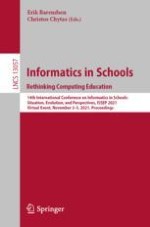2021 | Buch
Informatics in Schools. Rethinking Computing Education
14th International Conference on Informatics in Schools: Situation, Evolution, and Perspectives, ISSEP 2021, Virtual Event, November 3–5, 2021, Proceedings
herausgegeben von: Prof. Dr. Erik Barendsen, Christos Chytas
Verlag: Springer International Publishing
Buchreihe : Lecture Notes in Computer Science
